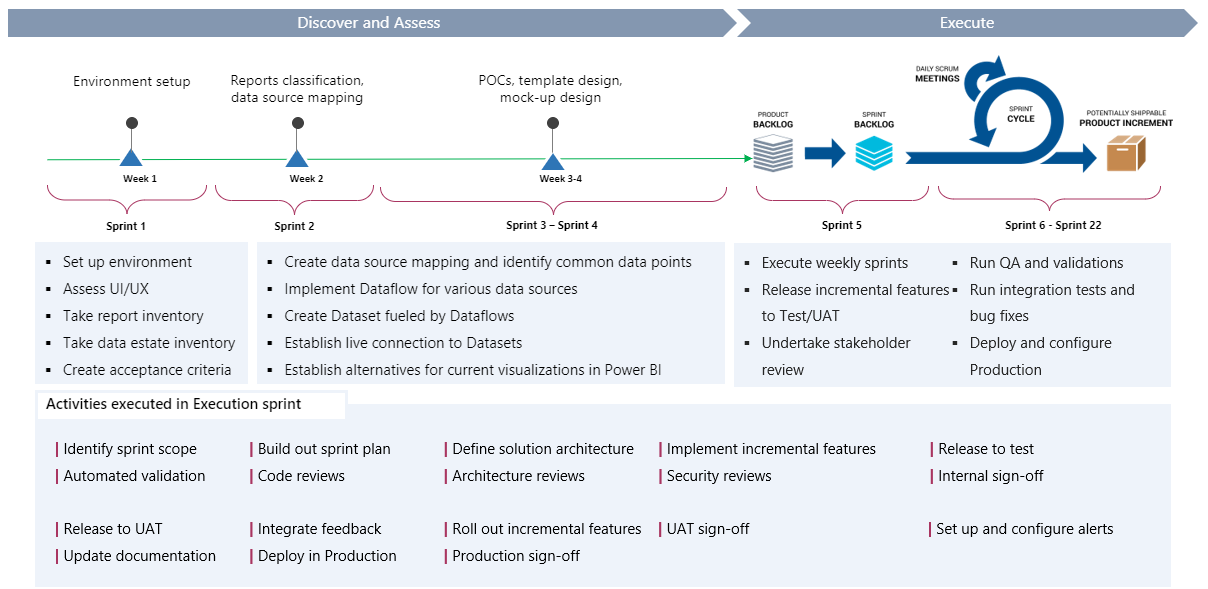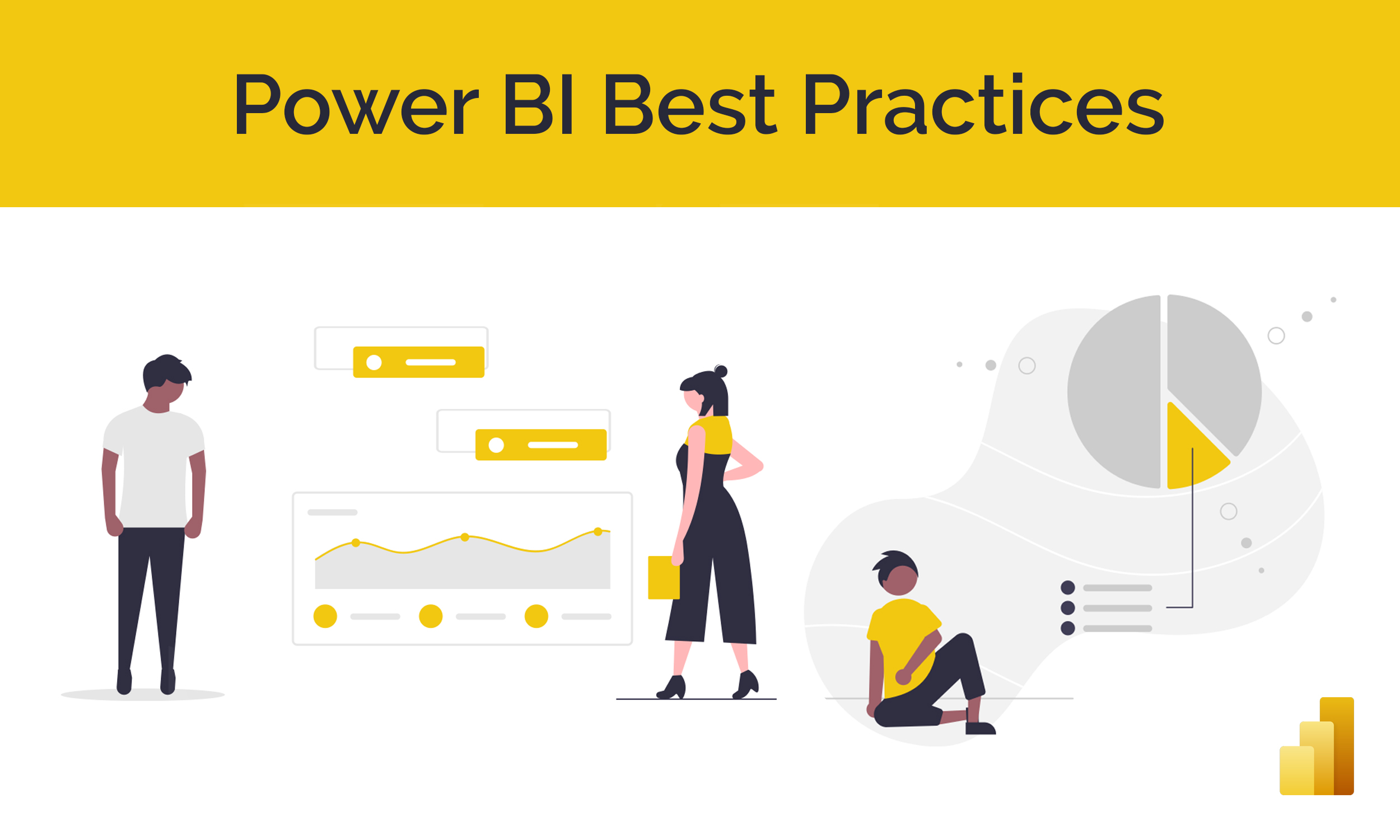What is Power BI?
Power BI is a business intelligence (BI) tool that enables users to easily transform their data into actionable insights. Business intelligence refers to the collection and analysis of business operation data. Insights from this data enable business leaders to identify growth opportunities and close operational gaps.
Previously, BI reporting platforms required developer expertise. Today, anyone can develop intuitive, insightful dashboards and reports with the right tool. Power BI is a powerful, easy-to-use tool that offers a wide range of storytelling visuals that help you understand your business opportunities.
Previously, BI reporting platforms required developer expertise. Today, anyone can develop intuitive, insightful dashboards and reports with the right tool. Power BI is a powerful, easy-to-use tool that offers a wide range of storytelling visuals that help you understand your business opportunities.
Power BI Migration Strategy
Large-enterprise companies rely on insights from BI platforms. When companies use unoptimized platforms, insights are slow, inaccurate, and siloed, delaying business-critical decisions for weeks. The most common issues our clients face with other BI platforms are:
Increasingly often, large-enterprise companies are turning towards Power BI. Power BI’s centralized, dynamic reporting better addresses their real-time business needs. However, migrating large volumes of data from enterprise systems can be challenging.
Managing terabytes of data and training thousands of team members in a new system requires meticulous planning. That’s where we come in. After leading over 100 Power BI migrations for large-enterprise companies, and implementing over 8,000 Power BI solutions, we’ve developed a simple six-step migration strategy. With our strategy, you can rest assured that we’ve covered all the bases, enabling you to migrate seamlessly to Power BI.
1. Slow-loading pages and reports
2. Difficulty managing and maintaining multiple data sources
3. Decentralized reporting
4. High maintenance costs
Increasingly often, large-enterprise companies are turning towards Power BI. Power BI’s centralized, dynamic reporting better addresses their real-time business needs. However, migrating large volumes of data from enterprise systems can be challenging.
Managing terabytes of data and training thousands of team members in a new system requires meticulous planning. That’s where we come in. After leading over 100 Power BI migrations for large-enterprise companies, and implementing over 8,000 Power BI solutions, we’ve developed a simple six-step migration strategy. With our strategy, you can rest assured that we’ve covered all the bases, enabling you to migrate seamlessly to Power BI.
1. Requirement Gathering and Analysis
Before we start actually moving data, it’s important to understand your current landscape. This means evaluating the existing reporting platform to understand your current needs, key functionalities, and gaps. We examine reports, dashboard usage, UI/UX, audiences, data sources, and security to create a report inventory and data estate. This information determines your migration scope, performance requirements, and complexity.
2. Planning and Design
Now that we understand your existing landscape, it’s time to move onto developing a road map. This sets the stage for the migration’s success. As Antoine de Saint-Exupéry once said, “A goal without a plan is just a wish.”
Here, we propose a solution based on all the requirements gathered in step one. To ensure everyone agrees with the plan of action, we set up a proposal meeting that involves architects, data administrators (admins), infrastructure admins, legal and security teams, and the Power BI product team (if required).
In general, we divide planning and design into five sub-steps:
Here, we propose a solution based on all the requirements gathered in step one. To ensure everyone agrees with the plan of action, we set up a proposal meeting that involves architects, data administrators (admins), infrastructure admins, legal and security teams, and the Power BI product team (if required).
In general, we divide planning and design into five sub-steps:
1. Perform a detailed gap analysis to identify the different features, visualization, and modeling challenges we need to address during migration
2. Propose a Power BI architecture, including security implementation, refresh latency, and report performance
3. Design report templates and prepare mock-ups
4. Define the scope for automated validation
5. Propose a deployment strategy and implementation timeframe
3. Execution
Now, it’s time to implement the approved solution architecture. Because we spend so much time on the planning stage, this step is straightforward. To optimize our workflow, we follow the agile methodology with the following steps:
1. Sprint plan: Create a product backlog and define the scope and length of sprints
2. Implementation: using best practices, reusable templates, and themes, start the report migration and provide incremental report builds
3. Performance tuning: Refine the architecture and report layout to optimize the data model for performance.
4. Testing: Use a set of in-house performance analysis tools to automate testing, which tracks query performance and suggests visual layout and data validation optimizations
5. Deployment: Close our sprint by automating report deployment and readying the build for user acceptance testing (UAT)
4. Deployment and Post-Production
During this step, we ensure the new reports are user-friendly and high-performing. First, we conduct numerous UAT sessions. UAT ensures the reports are optimized for their target audience. Once we receive sign-off for UAT and production, it’s time for deployment. We automate deployment, giving end users immediate access to the reports. To complete the transfer of ownership, we hand off the code, report, and workspace inventory to our client.
For many companies, Power BI migration ends here. However, we believe that successful adoption is a critical part of migrating to Power BI. That’s why we dedicate the next two steps to post-migration success.
5. Center of Excellence (CoE)
According to Microsoft, “A Center of Excellence (CoE) drives innovation and improvement and brings together like-minded people with similar business goals to share knowledge and success, while at the same time providing standards, consistency, and governance to the organization.”
During our CoE trainings, we enable our clients to become self-sufficient Power BI users. We run numerous CoE sessions that train team members across your organization in Power BI capabilities, governance, and best practices. These enable technical users, business users, and operations team members to become familiar with the new data system as the old system is gradually moved offline. Our custom trainings include regular office hours with certified engineers, an advanced curriculum, and pre-built solutions and frameworks. On average, our CoEs shorten the Power BI adoption timeframe from years to months.
If you are already at this migration stage, or need some help boosting Power BI adoption, check out our virtual CoE trainings, offered to any organization year-round:
6. Decommissioning
There’s nothing worse than a cluttered data system. To avoid redundancies, we systematically retire old reports. Here, our main goal is moving you onto the new system without impacting ongoing business operations. At MAQ Software, we believe migration to Power BI should be seamless.
 |
| Figure 1: Complete Process Overview |
Benefits of Migrating to Power BI
By migrating to Power BI using our six-step approach, our clients have benefitted from:
Quicker Insights for Decisionmakers
• Reduced latency between data sources and reports
• Increased scalability
Self-Service BI
• Business users can create reports and customize dashboards without developer expertise
Centralized Reporting
• Admins can easily manage and govern their organization’s reports with centralized administrative capabilities
• Users can combine data from different sources, such as Dynamics 365, Office 365, and hundreds of other relational databases
• Increased accuracy by offering a single source of truth for all reporting layers through shared datasets
Power BI Migration Case Studies
As the 2021 Microsoft Power BI Partner of the Year, we have experience migrating clients from a wide variety of data visualization platforms to Power BI. Our expertise enables us to easily manage large volumes of data and enable business continuity throughout the migration process. Here is a sample of how we’ve empowered our clients to migrate to Power BI.
Tableau to Power BI
Client: An international fast-moving consumer goods (FMCG) company.
Situation: Our client wanted to centralize their reporting platforms by migrating from Tableau to Power BI. As their existing Tableau reports were developed over time, it was complex to migrate them without compromising functionality.
How We Did It: We discussed each report in detail to understand its underlying business purpose. Then, we used our knowledge of Power BI to identify the best methods of achieving the same results in a new system. Spending time with the actual report users gave us insight into end user flow, enabling us to design an intuitive Power BI report.
Results: We migrated over 250 Tableau workbooks to Power BI. The new reports were better organized and decluttered. With easy navigation and optimized design, the new reports achieve the same functionalities as the old ones, with increased performance and accessibility. Our Center of Excellence trainings also helped increase post-migration adoption by 300%.
Qlik to Power BI
Client: EF Education First, a global education foundation with offices in 50 countries.
Situation: EF Education First needed a modern reporting platform with self-service analytics, easy scalability, and low operational costs.
How We Did It: We performed a gap analysis of the features and visualizations in Qlik and Power BI. Qlik supported 16 reports, with a data source consisting of 20+ SQL databases and 30 Excel sources. We ensured all required data could be transferred and visualized per the client’s needs.
Results: Power BI’s low-code architecture and cloud-based centralization, gave EF Education First access to self-service scalability.
Find out more about our QlikView to Power BI migration
SAP Business Objects (SAP BO) to Power BI
Client: A multinational food, snack, and beverage corporation with 250,000+ team members.
Situation: With our client’s high volume of data, their existing SAP BO reports took over five minutes to load. Running many slow-loading reports takes up the team’s valuable time, negatively impacting business operations.
How We Did It: We implemented a tabular model with Azure Analysis Services (AAS) to enable fast, efficient reporting in Power BI. Data loads from our client’s existing Teradata storage into AAS. For users with alternate view and calculation needs, reports can be exported directly from AAS to Excel. AAS is more equipped to store the huge models and pre-aggregated data needed for real-time visualization. AAS provides a dedicated central processing unit (CPU) and memory, independent of the load on premium capacity.
Results: Migrating from SAP BO to Power BI reduced reports run time by 90%. Previously, reports could take up to 5 minutes to load. With our solution’s back-end Azure Analysis Services (AAS), dense data now loads into Power BI in less than 20 seconds. Users can rapidly customize and run reports without the wait. AAS also has a built-in feature that provides time intelligence for KPIs on the fly.
MicroStrategy to Power BI
Client: A global Fortune 500 retailer.
Situation: Our client sends weekly and monthly report snapshots to subscribed internal and external users. MicroStrategy offers an easy and intuitive method to share reports like this. However, our client had recently migrated their other systems to Power BI as it offered better long-term scalability. To reduce costs, our client wanted to consolidate all functionalities to a single platform. We needed to implement a similar export/subscription functionality using Power Platform.
How We Did It: We used the existing subscription list and created a security model works with Power Automate schedules. Then, we converted data tables in MicroStrategy to paginated reports in Power BI. Using the Export API, the data can now be exported as an attachment to share with external and internal users.
Results: We helped our client retire their outdated MicroStrategy reports without losing their easy sharing capabilities. Because Power BI is part of the Power Platform, it integrates seamlessly with other powerful tools, such as Power Automate and Power Apps. Now, our client can view dashboards, manage reports, and share insights using a platform that is both scalable and sustainable.
Looker to Power BI
Client: A leading retail firm that provides office supplies.
Situation: Our client sought a centralized (BI) platform that delivers low operational and maintenance costs while providing self-service analytics capabilities. They also required seamless migration from their on-premises data source to a cloud-based one.
How We Did it: Our team established a centralized Power BI dataset by importing data from a cloud-based source. To optimize query performance and minimize costs, we implemented custom partitioning and incremental refresh policies in Power BI. By doing so, we reduced the overall number of queries fired to the cloud-based source. Our solution also met the customer's requirements for data refresh latency, ensuring that the dataset was always up-to-date and readily available for analysis.
Results: We assisted the client in retiring their Looker reports and migrating to Power BI, empowering end-users with self-service reporting capabilities. With Power BI's user-friendly interface, users can easily customize their report views and gain valuable insights. Power BI's built-in export functionalities also enable users to seamlessly share their findings with others, making it a more collaborative and efficient tool for the client's reporting needs.
Cognos to Power BI
Client: A global service provider in the Health, Tax & Accounting, Legal & Regulatory, and Finance industries.
Situation: Due to our client's high volume of reports, their existing Cognos reporting system had a high cost per click—on top of having limited UI features. This drawback led to a downward impact on business operations.
How We Did It: We implemented a tabular Microsoft SQL Server Analysis Services (SSAS) model that allowed for fast and efficient reporting in Power BI. The data from the client's existing data warehouse was loaded into SSAS, which is better equipped to store large models and pre-aggregated data needed for real-time visualization. With SSAS as the backend, reports can be generated directly from Excel for users with business priority and calculation needs. Additionally, SSAS provides a dedicated CPU and memory, which further optimizes the reporting process. Powerful features such as Export, Subscribe, and User Management (which can restrict users with lower privileges from publishing reports to the workspace) can easily be customized and managed using Power BI Report Server.
Results: Migrating from Cognos to Power BI reduced the cost per click by ~50%, while the aesthetically appealing visuals also improved the usage of the reports. Our solution allows for dense data to load into Power BI in less than 3 seconds, allowing users to rapidly customize with a better UI and run reports without delay. With SSAS, there is a built-in feature that provides time intelligence for KPIs on the fly, which further enhances the reporting process.
***
While our six-step migration strategy provides a general framework for success, each organization’s needs are different. Need help getting your Power BI migration on track? Partner with us by emailing Sales@MAQSoftware.com .
Up Next
To further improve your Power BI performance, check out our Power BI Best Practice Guide.


